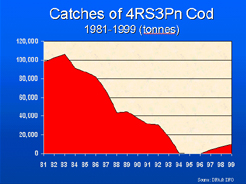|
|||||||||||||||||||||||||
|
The province's fishing industry experienced a dramatic transformation over the past decade, due primarily to the groundfish moratoria and the expansion of the shellfish sector. The industry has experienced unprecedented growth in landed and production values. Certain regions dependent on groundfish continue to face declines in groundfish landings. Fisheries diversification contributed significantly in recent years to the industry's performance and to the overall performance of the Newfoundland and Labrador economy. The fishery is key to economic growth in most rural areas of our province. Prudent fisheries management measures are critical to sustain this growth. Science is critical to the effective management of the province's marine resources and the conduct of sustainable and viable fisheries. In 1999:
Peak employment in the processing sector prior to the groundfish moratoria was approximately 25,000. In 1999, peak employment was approximately 16,700. On a per-unit basis, the output from the industry has a much higher average value than previously, reflecting market circumstances and product mix. In 1992, there were:
A number of plants have closed experienced very limited operations. Government's new processing licencing policy is centered on the core (multi-species) plants concept. As a result, 73 plants have been designated as core and have the flexibility to process a variety of species. The total number of active licenced primary plants in 1999 was 126 (63 core plants and 63 non-core). The number of buyer licences reduced to 73. There are now 9 secondary processing facilities. With the introduction of the processing licencing policy in 1997, Government no longer provides public funding for primary processing. Private sector investment will play a major role in the industries viability and future. There has been a substantial investment by processors and harvesters over the past three to four years. During this period, more than $125 million has been invested in the industry.
Northern Shrimp Fishery The crab fishery has become a significant contributor to the province's fishing industry.
Approximately 3,400 inshore enterprises now participate in this fishery and 35 licenced plants were active in 1999, with peak employment of approximately 7,000 workers.
The Department of Fisheries and Aquaculture placed considerable emphasis on identifying new resource opportunities. While new species opportunities have their limitations, their combined impact can have a significant impact on a number of individual enterprises in province. The $10 million Federal/Provincial Fisheries Diversification Program announced in the fall of 1999 will be of considerable benefit in advancing new opportunities for underutilized species. Over the past several years, the Province has undertaken, in conjunction with industry, a major thrust to improve the quality of fish landed and processed in this province. New regulations have been introduced, enforcement has been increased, and the benefits of delivering a high-quality product has been actively promoted. The challenge remains to continue to maximize the value of marine resources through the harvesting and production of high-quality products. Education and training is a key component of industry diversification. The industry and the Marine Institute of Memorial University have been very proactive in developing new courses and training programs. As well, the Professional Fish Harvesters Certification Board has developed educational programs for harvesters. New Developments The establishment of the Professional Fish Harvesters Certification Board has also been a positive development in the industry. Professional Fish Harvestors Certification Board
The Board is continuing the process of implementing a new professionalization program, including a Code of Ethics, formal education and training standards, and certification criteria for practicing fishers. Opportunities & Changes Efforts have to continue to maximize the value of all marine resources through quality assurance initiatives and value-added processing. Continued private-sector investment is required for industry growth and diversification. Capacity management in the processing and harvesting sector is an ongoing issue and a stable labour relations environment is essential for long-term industry stability and development. The overriding objective is to build on
the successes achieved over the past several years to maximize the
contribution of the fishing industry to the Province's economy The
diversification of the economy to create economic and social stability is
another key objective. Continued government and industry partnerships and
cooperation will be a critical factor in achieving this objective. |
|||||||||||||||||||||||||






